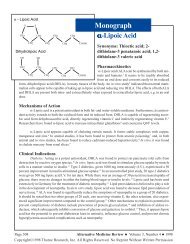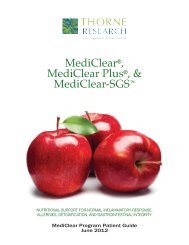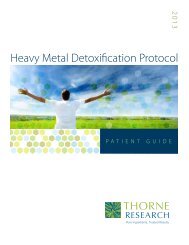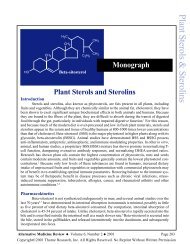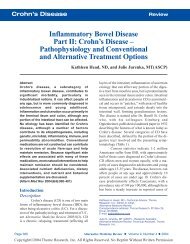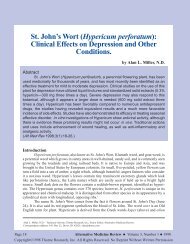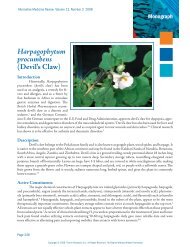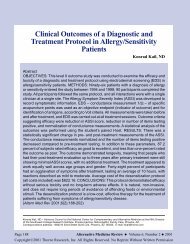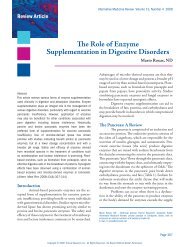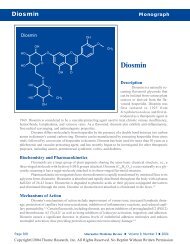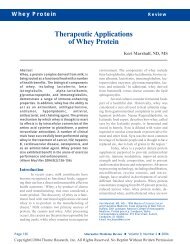Panax Ginseng - Thorne Research
Panax Ginseng - Thorne Research
Panax Ginseng - Thorne Research
You also want an ePaper? Increase the reach of your titles
YUMPU automatically turns print PDFs into web optimized ePapers that Google loves.
<strong>Panax</strong> ginseng and CancerReviewTable 1. Noteworthy Ginsenosides (28 are known)<strong>Panax</strong>adiols<strong>Panax</strong>atriolsRb1,Rb2, Rc, Rd, Rg3, Rh220(S)- protopanaxadiols(i.e., 20(S)-Rg3)Compound K, M1, IH901(20-O-β-D-glucopyranosyl-20(S)-protopanaxadiol); <strong>Panax</strong>ydiolKey GinsenosidesMetabolitesFurther MetabolitesRe, Rf, Rg1, Rg2, Rh120(S)- protopanaxatriols(i.e., 20(S)-Rg2 and 20(S)-Rh1)<strong>Panax</strong>ytriol(heptadeca-1-ene-4,6-diyne-3,9,10-triol)<strong>Ginseng</strong>’s saponins, generally calledginsenosides (Rx), are emphasized in cancerchemoprevention and therapeutics. The primaryginsenosides and their metabolic cousins have asteroid-like structure 2,3 and are generated by acidTable 2. Concentrations of Ginsenosides with AgeYears Total Saponins Rb Rg Ro(%) (%) (%) (%)2 1.97 0.88 0.54 0.133 2.20 1.03 0.62 0.174 4.75 2.27 1.10 0.405 4.60 2.08 1.19 0.216 3.84 1.94 0.81 0.299 3.81 2.32 0.46 0.40From: Liu CX, Xiao PG. Recent advances on ginsengresearch in China. J Ethnopharmacol 1992;36(1):27-38.hydrolysis of saponins 4 and human intestinal bacteria.5-7 With the exception of ginsenoside Ro,which is an oleanane-type triterpenoid, allginsenosides are the dammarane-type separatedinto panaxadiol and panaxatriol classes (Table 1).In Asia, the traditional preparationsof fresh white and red ginseng have variousconcentrations of ginsenosides that developin complexity with age (Table 2) and preparation.Classically, fresh ginseng is anythingpicked before four years of growth. Whiteginseng (picked at 4-6 years) is peeled andthen dried, and contains high concentrationsof Rb1, Rb2, Rc, and Rd of the -diol group.Red ginseng (harvested at 6 years) traversesboth ginsenoside classes speaking to liberationof new constituents – Rh1, Rh2, andRg3 – from steaming the dry whole root. 4,8These traditional preparations generate atherapeutic dose by stockpiling specificmetabolites for direct absorption and creatinga similar composite of primed metabolitesfor digestive processes to complex forabsorption (Figure 1).Page 260 Alternative Medicine Review ◆ Volume 9, Number 3 ◆ 2004Copyright©2004 <strong>Thorne</strong> <strong>Research</strong>, Inc. All Rights Reserved. No Reprint Without Written Permission



